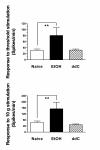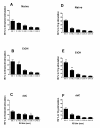Mechanically-evoked C-fiber activity in painful alcohol and AIDS therapy neuropathy in the rat
- PMID: 17319957
- PMCID: PMC1819368
- DOI: 10.1186/1744-8069-3-5
Mechanically-evoked C-fiber activity in painful alcohol and AIDS therapy neuropathy in the rat
Abstract
While altered activities in sensory neurons were noticed in neuropathic pain, caused by highly diverse insults to the peripheral nervous system, such as diabetes, alcohol ingestion, cancer chemotherapy and drugs used to treat AIDS, other infections and autoimmune diseases, as well as trauma, our understanding of how these various peripheral neuropathies manifest as altered neuronal activity is still rudimentary. The recent development of models of several of those neuropathies has, however, now made it possible to address their impact on primary afferent nociceptor function. We compared changes in mechanically-evoked C-fiber activity, in models of painful peripheral neuropathy induced by drinking ethanol (alcohol) or administering 2',3'-dideoxycytidine (ddC), a nucleoside reverse transcriptase inhibitor for AIDS therapy, two co-morbid conditions in which pain is thought to be mediated by different second messenger signaling pathways. In C-fiber afferents, ddC decreased conduction velocity. In contrast, alcohol but not ddC caused enhanced response to mechanical stimulation (i.e., decrease in threshold and increase in response to sustained threshold and supra-threshold stimulation) and changes in pattern of evoked activity (interspike interval and action potential variability analyses). These marked differences in primary afferent nociceptor function, in two different forms of neuropathy that produce mechanical hyperalgesia of similar magnitude, suggest that optimal treatment of neuropathic pain may differ depending on the nature of the causative insult to the peripheral nervous system, and emphasize the value of studying co-morbid conditions that produce painful peripheral neuropathy by different mechanisms.
Figures





Similar articles
-
Novel mechanism of enhanced nociception in a model of AIDS therapy-induced painful peripheral neuropathy in the rat.Pain. 2004 Jan;107(1-2):147-58. doi: 10.1016/j.pain.2003.10.010. Pain. 2004. PMID: 14715401
-
Alcohol consumption enhances antiretroviral painful peripheral neuropathy by mitochondrial mechanisms.Eur J Neurosci. 2010 Sep;32(5):811-8. doi: 10.1111/j.1460-9568.2010.07355.x. Epub 2010 Aug 19. Eur J Neurosci. 2010. PMID: 20726883 Free PMC article.
-
Altered temporal pattern of evoked afferent activity in a rat model of vincristine-induced painful peripheral neuropathy.Neuroscience. 2003;118(3):809-17. doi: 10.1016/s0306-4522(03)00023-x. Neuroscience. 2003. PMID: 12710988
-
Nucleoside analogue-associated peripheral neuropathy in human immunodeficiency virus infection.J Acquir Immune Defic Syndr Hum Retrovirol. 1995 Jun 1;9(2):153-61. J Acquir Immune Defic Syndr Hum Retrovirol. 1995. PMID: 7749792 Review.
-
Cutaneous pain in disorders affecting peripheral nerves.Neurosci Lett. 2021 Nov 20;765:136233. doi: 10.1016/j.neulet.2021.136233. Epub 2021 Oct 1. Neurosci Lett. 2021. PMID: 34506882 Free PMC article. Review.
Cited by
-
Abnormal muscle afferent function in a model of Taxol chemotherapy-induced painful neuropathy.J Neurophysiol. 2011 Jul;106(1):274-9. doi: 10.1152/jn.00141.2011. Epub 2011 May 11. J Neurophysiol. 2011. PMID: 21562188 Free PMC article.
-
The Molecular and Pharmacological Mechanisms of HIV-Related Neuropathic Pain.Curr Neuropharmacol. 2013 Sep;11(5):499-512. doi: 10.2174/1570159X11311050005. Curr Neuropharmacol. 2013. PMID: 24403874 Free PMC article.
-
Sex Differences in the Expression of Neuroimmune Molecules in the Spinal Cord of a Mouse Model of Antiretroviral-Induced Neuropathic Pain.Biomedicines. 2023 Mar 13;11(3):875. doi: 10.3390/biomedicines11030875. Biomedicines. 2023. PMID: 36979854 Free PMC article.
-
Stress enhances muscle nociceptor activity in the rat.Neuroscience. 2011 Jun 30;185:166-73. doi: 10.1016/j.neuroscience.2011.04.020. Epub 2011 Apr 15. Neuroscience. 2011. PMID: 21513773 Free PMC article.
-
Nociceptor Sensitization Depends on Age and Pain Chronicity(1,2,3).eNeuro. 2016 Feb 8;3(1):ENEURO.0115-15.2015. doi: 10.1523/ENEURO.0115-15.2015. eCollection 2016 Jan-Feb. eNeuro. 2016. PMID: 26866058 Free PMC article.
References
Publication types
MeSH terms
Substances
Grants and funding
LinkOut - more resources
Full Text Sources
Medical

